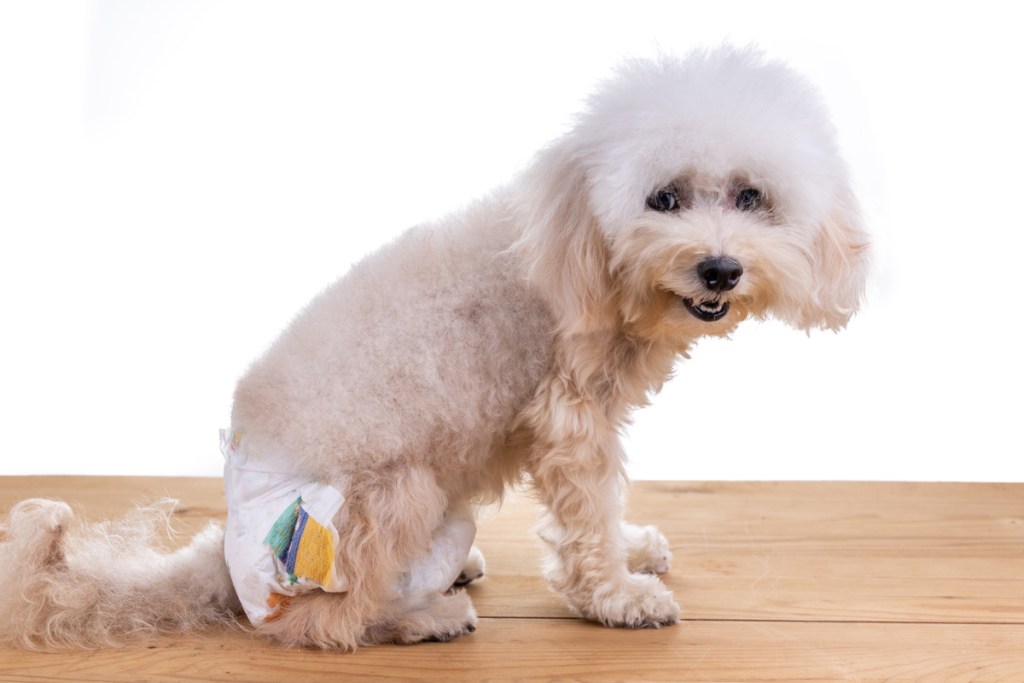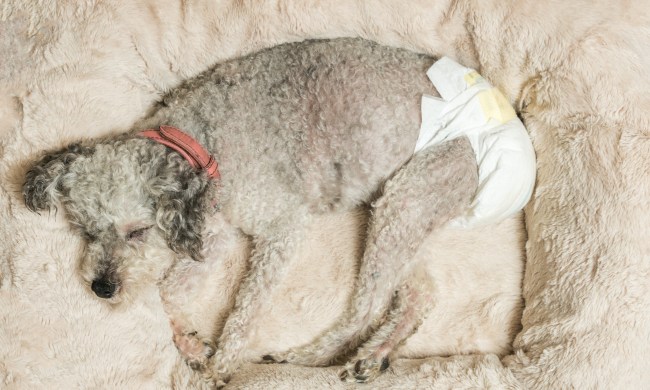Depending on your dog’s age, if you adopted her from a shelter or rescue group, chances are she’s been spayed, so you don’t need to worry about heat cycles. However, if you purchased your female puppy from a breeder or pet store, part of being a responsible dog owner is learning all you can about a dog’s estrus cycle. That includes learning when she will go into heat, how often it will happen, how long it will last, and how to take care of your dog when she is in heat.

What it means when your dog goes into heat
According to the American Kennel Club (AKC), female dogs reach sexual maturity around six months of age, and that’s when they typically have their first heat or estrus cycle. This can vary depending on the dog. Some smaller breeds may go into heat at four months, while some of the giant breeds may reach two years of age before having their first heat cycle. Females go into heat about every six months, but this, too, can vary, especially with younger or older dogs. Breed experts at the AKC say small dogs tend to go into heat more frequently, as much as three times a year, while giant breeds may cycle only once a year.

Symptoms that your dog is in heat
Swelling around the vulva. The first sign that your dog is going into heat is swelling around her vulva and bloody or straw-colored discharge. You may notice your female excessively licking her genital area.
Irritability followed by flirtatiousness. During this time, there’s an increase in the dog’s estrogen levels followed by a sharp decrease, and then her ovaries release eggs. During the first phase of the heat cycle, called the proestrus, your dog might become irritable and even act aggressively toward other dogs. However, when she moves into the estrus stage, she will become flirtatious with male dogs. This typically happens around day eleven, say veterinarians at the VCA Animal Hospitals.
More frequent urination. When a female dog is in heat, her vaginal and urinary secretions contain pheromones and hormones that attract males. Females in heat will typically urinate more frequently or mark objects around the house or while on a walk to attract the attention of male dogs.

How to take care of a dog in heat
Step 1: Provide a calm, quiet environment
Dogs in heat often appear anxious and restless due to fluctuating hormone levels. Playing soft music and providing a nice warm bed in her favorite spot can help her relax. Interactive puzzle toys and safe chew bones can help soothe an anxious dog.
Step 2: Stock up on dog diapers
You’ll need to manage the bloody discharge around the house while your dog goes through her heat cycle. Consider using reusable or disposable diapers. If it’s challenging to keep regular diapers on your dog, a full-body diaper is a great alternative.
Step 3: Provide adequate nutrition
It’s important to make sure your dog is getting adequate nutrition when she is in heat. Some females will go off their regular food during this time, so you may have to prepare special meals to encourage her to eat.
Step 4: Take your dog outside more frequently
Never reprimand your dog if she has accidents in the house. This is normal behavior when she’s in heat. Instead, reassure her and take her outside more frequently, but always on a leash.
Step 5: Check the yard for any possible escape routes
A female in heat may try to escape from her yard in search of a male. This is an instinctual behavior, so be sure to check the yard for any possible escape routes. Never allow your dog outside unsupervised when she’s in heat, and never walk her off-leash.
Step 6: Keep her at home
Don’t take your dog to public parks, pet stores, or training classes where you are likely to meet intact males.

Preventing unwanted pregnancy
To avoid unwanted pregnancy, don’t make the mistake of thinking your dog is no longer in heat when she stops bleeding. While bleeding may last for only the first two weeks, veterinary experts say that in the last two weeks, when discharge is more watery and pinkish, females are most fertile. They recommend keeping a female in heat away from intact males for up to four weeks. You’ll know the heat cycle has ended when your dog’s vulva returns to its normal size and there’s no more discharge.
Caring for a dog during her heat cycle is hard work. You can avoid it by having your dog spayed. There are many great reasons to do this. Millions of dogs are euthanized every year, and having your dog spayed will help reduce pet overpopulation. It also carries health benefits. According to the American Veterinary Medical Association, early spaying of female dogs can help protect them from some serious problems later in life, such as uterine infections and breast cancer. The surgery has no negative impact on dogs, allowing for years of loving companionship without the challenge of managing heat cycles.




